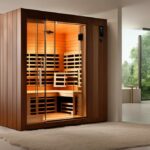Last Updated on 5 months by Francis
If you’re considering investing in an infrared sauna, one important factor to consider is how much electricity it will use. In this section, we will explore the topic of electricity usage in infrared saunas and provide insights into the factors that impact consumption and costs.
Before we dive into the details, it’s worth noting that the amount of electricity an infrared sauna uses can vary significantly depending on several factors. These factors include the size of the sauna, the temperature you set it to, and how frequently you use it.
That being said, let’s take a closer look at the factors that impact the electricity usage of an infrared sauna and how you can estimate the cost of running one.
Contents
Key Takeaways:
- The amount of electricity an infrared sauna uses can vary depending on several factors.
- The size of the sauna, the temperature setting, and usage frequency can impact electricity consumption.
- It’s important to estimate the cost of running an infrared sauna before making a purchase.
- By understanding the factors that impact electricity usage, you can make informed decisions to reduce energy costs.
- Investing in an energy-efficient model can also help lower electricity expenses in the long run.
How Infrared Saunas Work
Before delving into the electrical requirements of an infrared sauna, it’s essential to understand how they work. Unlike traditional saunas, which use heated rocks to generate steam, infrared saunas use infrared heaters to emit light that is absorbed by the human body. This absorption creates heat, which raises the body’s core temperature and induces a sweat.
The heat generated by infrared saunas is similar to that produced by the sun, without the harmful ultraviolet rays. Infrared waves penetrate the body’s tissues, producing a deep, detoxifying sweat that provides numerous health benefits.
To function correctly, a typical infrared sauna requires an electrical supply of 120V AC, 15 Amps. This means that a dedicated 15 Amp circuit breaker must be installed in your home’s electrical panel to power your sauna.
| Infrared Sauna Electrical Requirements | Recommendations |
|---|---|
| Electrical Supply | 120V AC, 15 Amps |
| Dedicated Circuit Breaker | Yes, 15 Amps |
| Outlet Type | 5-15R, 15 Amps |
It’s important to consult with a licensed electrician when installing your infrared sauna to ensure that all electrical requirements are met and that your sauna operates safely and efficiently.
Factors Affecting Electricity Usage
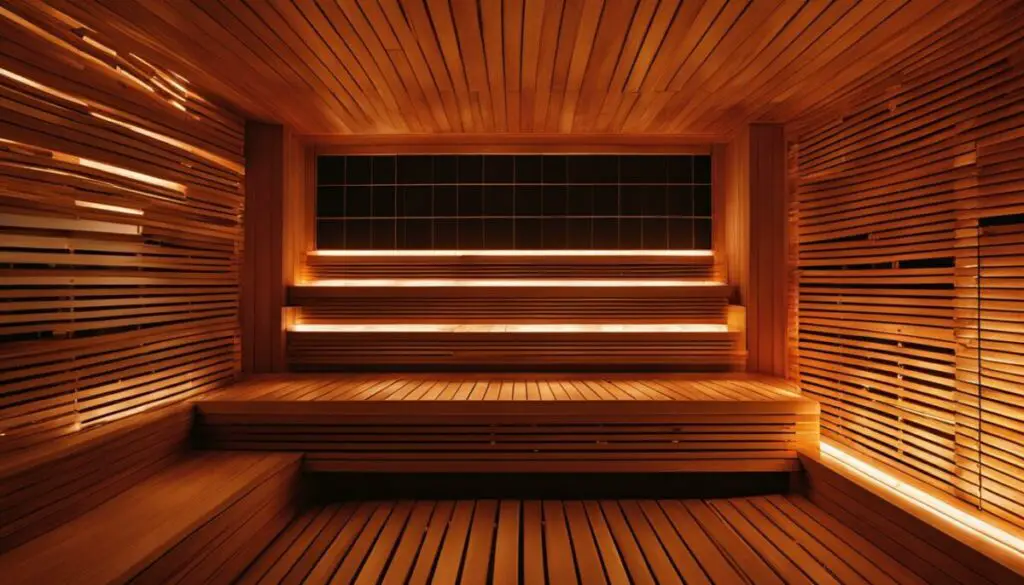
Several factors can impact the energy efficiency of your infrared sauna. To maximize efficiency and minimize electricity usage, it’s necessary to consider these factors:
| Factor | Description |
|---|---|
| Infrared sauna size | The size of your infrared sauna affects how much energy it consumes. Generally, larger saunas require more electricity to heat up and maintain the desired temperature. |
| Insulation | Good insulation is crucial for preventing heat loss and ensuring your sauna consumes less electricity. Poor insulation can cause heat to escape, leading to increased energy consumption and higher costs. |
| Frequency of use | The more frequently you use your infrared sauna, the more electricity it will consume. To save on electricity costs, it’s essential to find the right balance between usage and cost-efficiency. |
| Temperature settings | Higher sauna temperature settings require more electricity to maintain. By setting your sauna to a slightly lower temperature, you can reduce electricity usage and still enjoy the benefits of infrared heat. |
| Number of users | The number of people using your infrared sauna also affects energy consumption. More people generate more heat, which can cause the sauna to consume more electricity to maintain the desired temperature. |
To ensure optimal energy efficiency, it’s essential to consider these factors when deciding how often and for how long to use your infrared sauna. By making small adjustments, you can save on energy costs and enjoy the benefits of infrared heat without breaking the bank.
Calculating Electricity Consumption

Calculating the electricity consumption of your infrared sauna is essential for estimating energy costs accurately. To determine how much electricity your infrared sauna uses, you need to know the kilowatt (kW) usage of the unit and how long you plan to use it. Here is an example:
| Infrared Sauna | Kilowatt Usage | Usage Time | Electricity Consumption |
|---|---|---|---|
| Sauna A | 1.5 kW | 1 hour | 1.5 kWh |
| Sauna A | 1.5 kW | 2 hours | 3 kWh |
As you can see, the electricity consumption of an infrared sauna will vary based on the unit’s kilowatt usage and how long it is used. It’s essential to calculate your estimated energy consumption to manage costs and create a budget for your infrared sauna use.
Another way to estimate electricity consumption is by using an energy monitor. These devices can be connected to your infrared sauna’s electrical outlet and will track how much electricity the unit uses over time. By monitoring your usage, you can identify opportunities to reduce energy consumption and save on electricity costs.
Now that you know how to calculate electricity consumption let’s move on to real-life examples in the next section.
Real-Life Examples of Electricity Usage

Understanding the electricity usage of an infrared sauna can be challenging, but we have some real-life examples to give you a better idea. On average, an infrared sauna uses between 1.6 to 3.2 kilowatts of electricity per hour, depending on the size and model of the sauna.
For example, a smaller two-person sauna might use around 1.6 kilowatts per hour, whereas a larger six-person sauna could use up to 3.2 kilowatts per hour. These estimates are based on average usage, and actual usage may vary depending on factors like the length of your sauna session and the temperature setting.
To put this into perspective, the average cost of electricity in the United States is 13.31 cents per kilowatt-hour. So, if you use a two-person infrared sauna for an hour each day, it would cost you approximately $24.35 per month in electricity.
It’s essential to note that these calculations are just estimates, and actual usage may vary depending on your individual circumstances. However, having a rough idea of how much electricity your infrared sauna consumes can help you budget and plan accordingly.
Tips for Energy Efficiency

Maximizing energy efficiency in your infrared sauna can not only reduce your electricity usage but also prolong the lifespan of your sauna. Here are some tips to follow:
- Choose the right size: For optimal energy efficiency, select a sauna size that fits your needs. A smaller sauna will require less energy to heat up.
- Invest in insulation: Proper insulation can significantly reduce heat loss and improve energy efficiency. Consider adding insulation to your sauna if it’s not already included.
- Use a timer: A timer can help you control your sauna’s energy usage by automatically turning it off after a set amount of time.
- Keep your sauna clean: A dirty sauna can lead to poor energy efficiency. Regularly cleaning your sauna can help it run more efficiently.
- Preheat your sauna: Preheating your sauna can reduce the amount of time it takes to reach the desired temperature, saving you energy in the long run.
“Maximizing energy efficiency in your infrared sauna can not only reduce your electricity usage but also prolong the lifespan of your sauna.”
Understanding Electricity Costs in Infrared Saunas
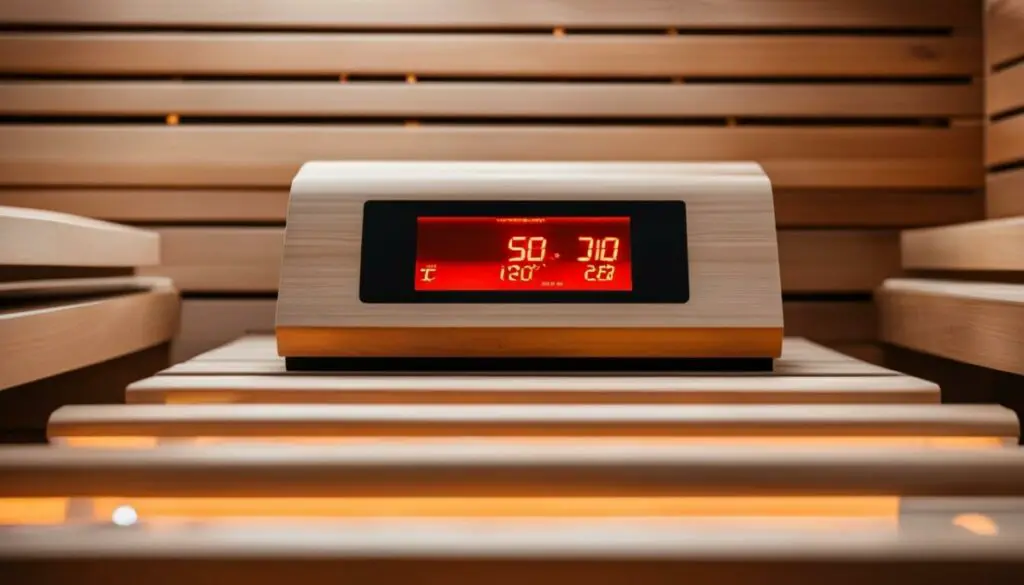
When it comes to estimating the cost of running an infrared sauna, understanding the associated electricity costs is crucial. Electricity costs can vary depending on factors like energy efficiency, electricity rates in your area, and the size of your sauna.
One way to estimate electricity costs is to consider the wattage of your infrared sauna. Most infrared saunas require between 1200 and 1400 watts to operate. If you know the cost per kilowatt-hour (kWh) of electricity in your area, you can estimate the hourly cost of running your sauna.
| Infrared Sauna Wattage | Hourly Cost (at $0.12 per kWh) |
|---|---|
| 1200 watts | $0.14 |
| 1300 watts | $0.15 |
| 1400 watts | $0.17 |
It’s important to note that this is just an estimate, and actual costs may vary based on usage patterns and other factors. Fortunately, there are several ways to manage and minimize electricity costs associated with your infrared sauna.
Tip: Consider using your infrared sauna during off-peak hours when electricity rates are lower to save on energy costs.
Additionally, investing in an energy-efficient infrared sauna can help you reduce your electricity costs over time. Look for saunas with features like low EMF (electromagnetic field) emissions, LED lighting, and triple-layered walls for optimal energy efficiency.
By understanding and managing your electricity costs, you can enjoy the benefits of your infrared sauna while keeping energy expenses in check.
Energy Saving Features in Infrared Saunas
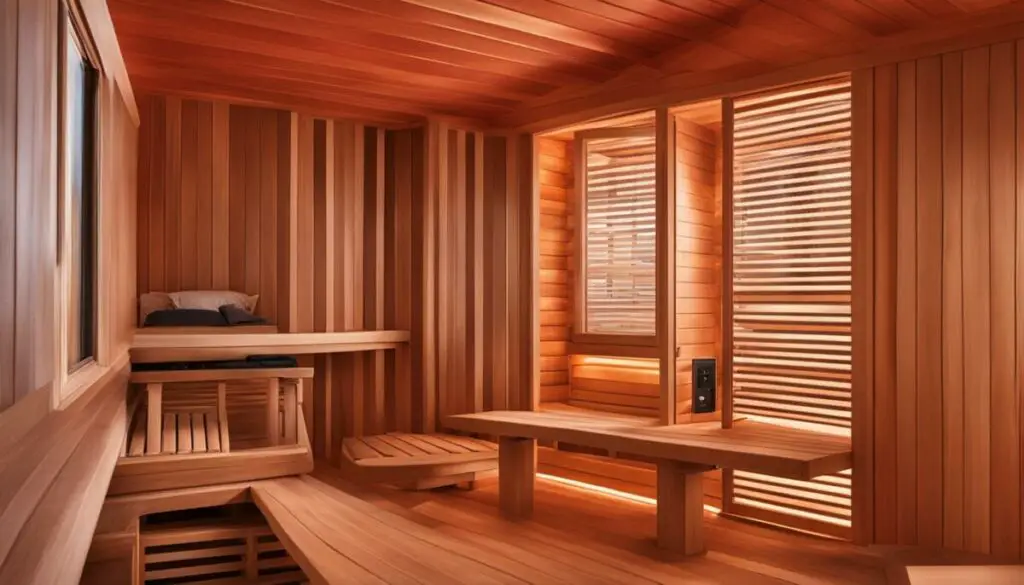
Modern infrared saunas often come equipped with several energy-saving features that can help reduce electricity usage and lower energy costs. These features include:
- LED Lighting: Many infrared saunas use LED lighting, which is more energy-efficient than traditional lighting methods. LED lights consume less power and have a longer lifespan, making them a more eco-friendly option.
- Low EMF Heaters: Infrared saunas with low EMF (electromagnetic field) heaters consume less electricity while providing the same level of warmth and comfort. Low EMF heaters also emit fewer harmful electromagnetic waves, making them a safer option for your health.
- Programmable Timers: Programmable timers can help you set your sauna to turn on and off at specific times, allowing you to save energy when the sauna is not in use.
By choosing an infrared sauna with energy-saving features, you can enjoy all the benefits of a sauna while minimizing your energy usage and costs.
Comparing Infrared Saunas to Traditional Saunas
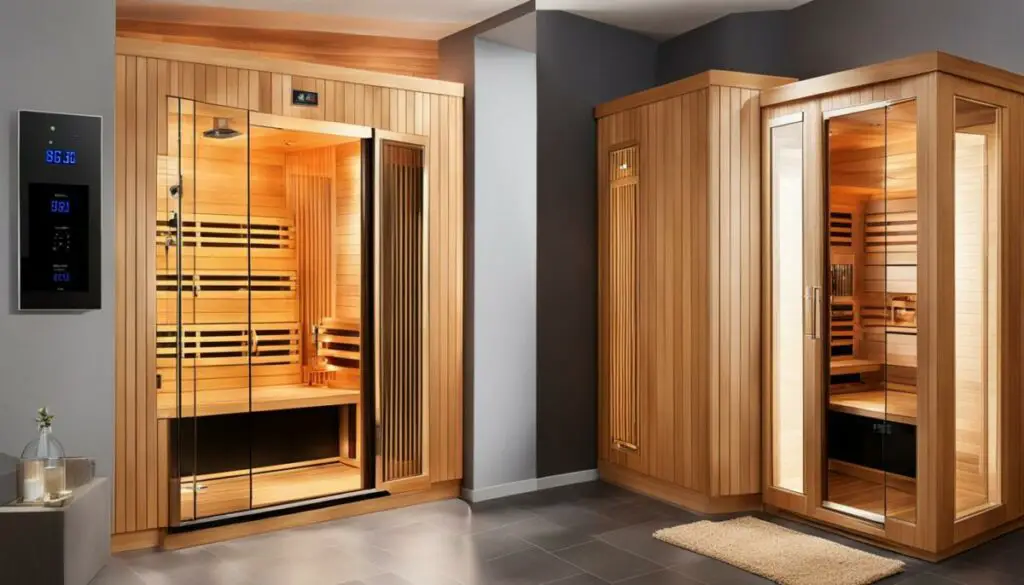
When it comes to power consumption, infrared saunas are the clear winner over traditional saunas. Infrared saunas use much less electricity than traditional saunas, making them a more energy-efficient option.
The average power consumption of an infrared sauna is between 1.6 and 3.2 kilowatts, while a traditional sauna can use anywhere from 6 to 12 kilowatts. This means that using an infrared sauna can save you a significant amount on your electricity bill compared to using a traditional sauna.
| Infrared Sauna | Traditional Sauna | |
|---|---|---|
| Power Consumption (kilowatts) | 1.6 – 3.2 | 6 – 12 |
| Energy Efficiency | High | Low |
| Cost | Lower overall cost due to lower electricity usage | Higher overall cost due to higher electricity usage |
Additionally, traditional saunas require a preheating period of 30 minutes to an hour, during which the heating elements are consuming electricity but not providing any benefits. In contrast, infrared saunas require only a few minutes to reach your desired temperature, greatly reducing energy waste.
Overall, if you’re looking for an energy-efficient sauna option, an infrared sauna is the clear choice. With its lower power consumption and quicker heat-up time, it’s a more cost-effective and eco-friendly option than a traditional sauna.
Tips for Monitoring and Managing Infrared Sauna Electricity Consumption
To ensure maximum energy efficiency and minimize electricity costs, it’s important to monitor and manage your infrared sauna’s electricity consumption. Here are some tips:
1. Use a Smart Power Strip
Consider using a smart power strip that can detect when your infrared sauna is not in use and automatically shut off power to all connected devices. This eliminates standby power consumption and can save you money on your electricity bill.
2. Optimize Your Sauna Usage
Establish a regular sauna routine that works for you. Avoid turning your sauna on and off frequently and try to use it during off-peak hours when electricity rates may be lower. This can help reduce overall energy consumption and lower costs.
3. Insulate Your Sauna
Proper insulation can help retain heat and reduce energy usage in your sauna. Make sure your sauna is properly insulated, and consider using a sauna cover when not in use to help retain heat and reduce energy consumption.
4. Keep Your Sauna Clean
A clean sauna can operate more efficiently and use less electricity. Regularly clean your sauna’s heating elements and replace any damaged parts to ensure optimal performance and energy efficiency.
5. Invest in Energy-Efficient Models
Consider investing in an energy-efficient infrared sauna model that meets your needs. Look for saunas with low wattage heaters and advanced controls that allow you to customize your sauna experience and optimize energy usage.
Investing in Energy-Efficient Infrared Saunas
If you’re looking to maximize energy efficiency in your infrared sauna, investing in an energy-efficient model can be a wise choice. There are several key factors to consider when choosing the right sauna for your home.
- Size: Larger saunas will typically require more electricity to operate. If you’re looking to minimize energy usage, consider a smaller model that will fit your needs without excess power consumption.
- Heating technology: Certain infrared heating technologies can be more efficient than others. Look for models that use low-EMF carbon heaters or ceramic heaters, which are known for their energy efficiency.
- Insulation: Well-insulated saunas will retain heat more effectively, reducing the amount of energy needed to maintain a consistent temperature. Look for models with thick walls and airtight seals.
- Control options: Saunas with advanced control options allow you to customize the temperature and duration of your session more precisely. This can help you avoid unnecessary energy usage and optimize your sauna experience.
Remember to consider your specific needs and usage patterns when choosing an infrared sauna. While energy efficiency is important, you should also prioritize comfort, convenience, and other factors that will impact your overall satisfaction with the sauna.
By investing in an energy-efficient infrared sauna, you can reduce your electricity usage and save on energy costs while enjoying the many health benefits of sauna sessions.
Conclusion
Infrared saunas are an excellent way to relax, detoxify, and improve overall health. However, it’s essential to understand how much electricity they use and how to manage those costs effectively. By considering factors like energy efficiency, monitoring usage, and investing in the right sauna model, you can optimize your sauna experience while minimizing electricity expenses.
Takeaways:
- Factors impacting electricity usage include the size of the sauna, usage frequency, and temperature settings.
- Calculating electricity consumption involves knowing the kilowatt usage and calculating the hourly rate.
- Real-life examples of electricity usage can help estimate potential costs.
- Energy-saving features and investing in energy-efficient models can save on electricity costs long-term.
By incorporating these takeaways into your sauna usage routine, you can enjoy the benefits of infrared saunas while managing your electricity costs and overall energy consumption.
FAQ
How much electricity does an infrared sauna use?
The electricity usage of an infrared sauna can vary depending on factors such as sauna size, heating elements, and usage duration. On average, an infrared sauna may consume between 1.6 to 3.2 kilowatts per hour.
What are the electrical requirements for an infrared sauna?
Infrared saunas typically require a dedicated electrical circuit, usually 120V or 240V, depending on the size and power requirements of the sauna. It is best to consult the manufacturer’s specifications for the specific electrical requirements your sauna model.
What factors can affect the electricity usage of an infrared sauna?
Several factors can impact the electricity usage of an infrared sauna, including the sauna’s insulation, ambient temperature, usage duration, and the number of heating elements. Additionally, maintaining proper maintenance and ventilation can also contribute to energy efficiency.
How can I calculate the electricity consumption of an infrared sauna?
To calculate the electricity consumption of an infrared sauna, you can multiply the sauna’s power rating (in kilowatts) by the number of hours it is used. For example, if your sauna is rated at 2 kilowatts and you use it for 2 hours, the electricity consumption would be 4 kilowatt-hours.
Can you provide real-life examples of electricity usage in infrared saunas?
While electricity usage can vary depending on individual usage patterns, a general estimate is that an hour of infrared sauna usage may cost between $0.20 to $0.50 in electricity, based on average electricity rates. It’s important to check with your local utility provider for accurate pricing information.
How can I maximize energy efficiency in my infrared sauna?
To maximize energy efficiency in your infrared sauna, you can ensure proper insulation, maintain regular maintenance, use timers to control usage duration, and adjust temperature settings according to your comfort level. Additionally, minimizing heat loss by keeping the sauna door closed and using energy-saving features, if available, can also help reduce electricity usage.
How are electricity costs calculated for running an infrared sauna?
Electricity costs for running an infrared sauna are calculated based on the kilowatt-hour (kWh) rate charged by your utility provider. To determine the cost, multiply the electricity consumption (in kWh) by the rate per kWh. For example, if your sauna consumes 3 kWh and your rate is $0.15 per kWh, the cost would be $0.45.
Do infrared saunas come with energy-saving features?
Yes, many modern infrared saunas come equipped with energy-saving features such as timers that allow you to set usage duration, temperature controls to minimize energy consumption, and automatic shut-off functions. These features help optimize energy efficiency and reduce electricity usage.
How does the electricity usage of infrared saunas compare to traditional saunas?
Infrared saunas are generally more energy-efficient compared to traditional saunas. Traditional saunas rely on heating the air in the room, while infrared saunas directly heat the body. This focused heating method can result in lower electricity usage and potentially save on energy costs.
How can I monitor and manage the electricity usage of my infrared sauna?
To monitor and manage electricity usage, you can use a kilowatt-hour meter or a smart plug that tracks energy consumption. These devices allow you to monitor usage and make adjustments to optimize energy efficiency. Additionally, setting a usage schedule and keeping track of usage duration can also help manage electricity consumption.
Are there energy-efficient infrared saunas available in the market?
Yes, there are energy-efficient infrared sauna models available in the market. When choosing an energy-efficient sauna, look for features such as high-quality insulation, low EMF (electromagnetic field) emissions, efficient heating elements, and energy-saving controls. It’s recommended to research and compare different models to find the most energy-efficient option that suits your needs.


